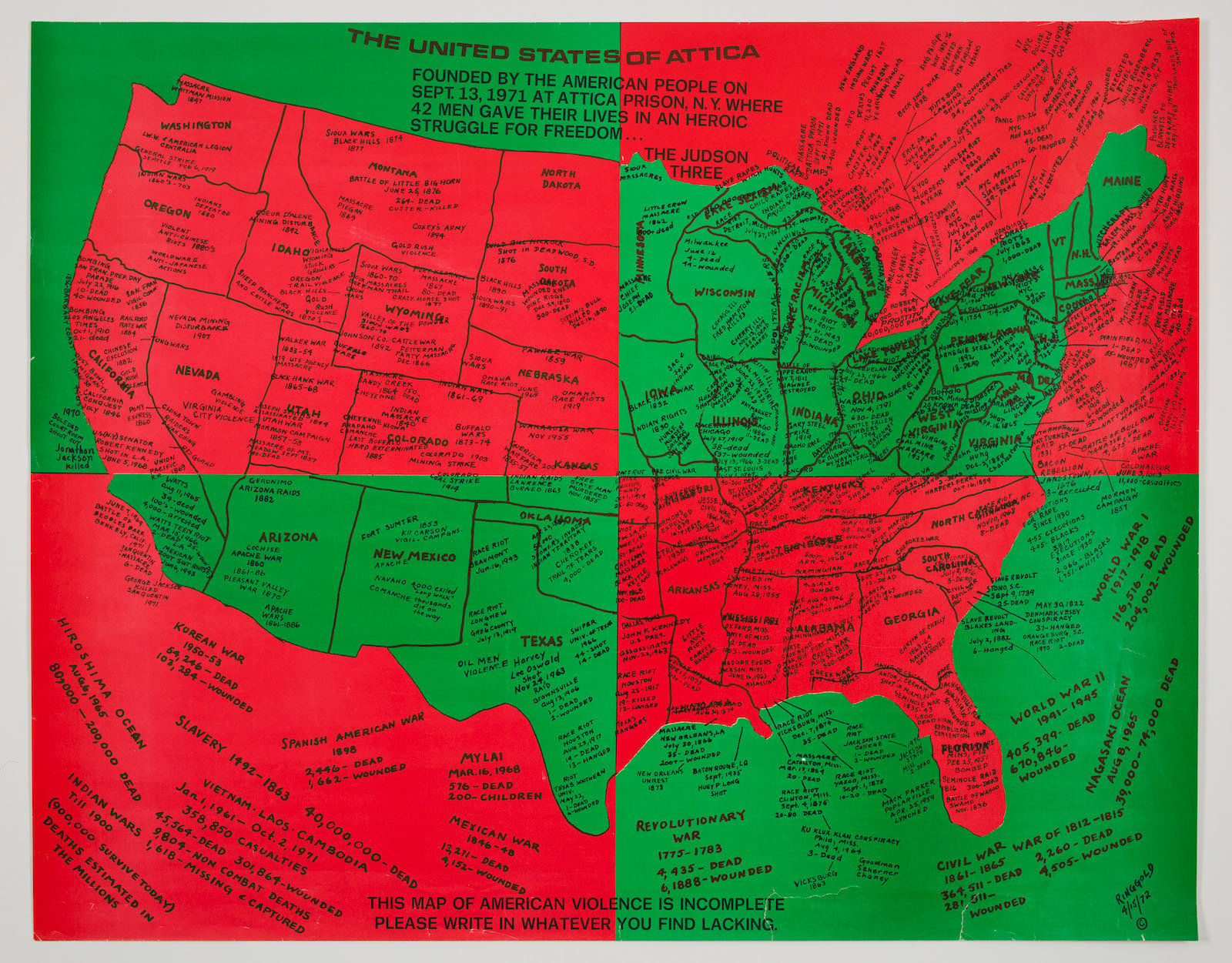
I’m still quoting a joke that arts philanthropist Agnes Gund made six years ago. Speaking about her Black grandchildren, she mentioned a pillow she has embroidered with the words along the lines of: “If I knew grandchildren were this much fun, I would have had them first.”
The president emerita of the Museum of Modern Art delivered this line at a 2017 event at the New York institution inaugurating the Art for Justice Fund, a project she founded with the Ford Foundation and Rockefeller Philanthropy Advisors to fight the racist scourge of mass incarceration in America. With just 4.25 percent of the world’s population, the U.S. houses a fifth of the world’s prison inmates at an annual cost of about $81 billion. (Apropos of those grandchildren, Black minors are four times as likely to be incarcerated as their white counterparts.)
Julie Mehretu, Rubber Gloves (2018). Photo by Tom Powel. Courtesy of Marian Goodman Gallery and Ford Foundation Gallery.
Now, the exhibition, “No Justice Without Love,” at the Ford Foundation Gallery in New York celebrates the end of the six-year lifespan of the initiative, which focuses on bail reform, sentencing reform, and developing reentry opportunities for the formerly incarcerated.
It features major figures such as Titus Kaphar, Julie Mehretu, and Faith Ringgold, along with artists on the rise like Jesse Krimes and Sherrill Roland, as well as collectives like For Freedoms and the People’s Paper Co-op. Some of the artists, including Krimes and Roland, were formerly incarcerated; Krimes just launched the Center for Art and Advocacy, dedicated to mentoring those formerly incarcerated, with money from the Art for Justice Fund.
Bayete Ross Smith, still from How A White Mob Destroyed a City and Got Away With It, from the Red Summers 2021. Courtesy of the Artist and Ford Foundation Gallery.
Curated by Daisy Desrosiers, director and chief curator at Gund Gallery at Kenyon College, the show includes works that visualize the mass incarceration system and its wide-ranging effects in various ways.
Some focus on infrastructure, at differing scales. At the show’s entrance, for example, is a video animation by Paul Rucker, Proliferation (2009), that shows the U.S. as if seen from a satellite, with glowing dots of various colors mapping the growth of the prison system, set to Rucker’s music. A 19-foot-tall print by Maria Gaspar reproduces the exterior of Cook County Jail at life size; next to it hangs a minimalist-looking sculpture by Roland that traces the mortar lines between cinder blocks that make up the walls of cells like the one where he spent more than 10 months for a crime he didn’t commit.
Other works address the situation more obliquely: for example, Titus Kaphar’s 2019 painting From a Tropical Space, in which two Black women appear with strollers with white spaces where the children should be, as if stolen from them. Krimes’s quilt Marion (2021), meanwhile, depicts an outdoor scene of the type to which an imprisoned person might wish to return, made partly from used clothing collected from incarcerated people.
The show partly aimed to answer the question, “How do you organize a show about a fund?” In partial answer is a “Call and Response” section, devoted to acknowledgements from cultural practitioners who have received support from the fund, in the form of letters, artworks, audio, and video. After the show closes, it will remain available on Art for Justice’s website.
See more images from the show below.
Jesse Krimes, Marion (2021). Courtesy the artist and Ford Foundation Gallery.
Maria Gaspar, Unblinking Eyes, Awaiting (2023). Courtesy of the artist and Ford Foundation Gallery. Photo by Sebastian Bach.
Sherrill Roland, 168.803 (2021). Courtesy of Tanya Bonakdar Gallery and Ford Foundation Gallery.
The People’s Paper Co-op in collaboration with Kill Joy and PPC Fellows: Faith Bartley, Nashae Cooper, Tinika Hogan, Ivy Johnson, Janaya Pulliam, My Power Within (2021). Courtesy of The People’s Paper Co-op.
Titus Kaphar, From a Tropical Space (2019). Courtesy of the Museum of Modern Art, New York.
“No Justice Without Love” is on view at the Ford Foundation Gallery, 320 E 43rd St, New York, through June 30.
More Trending Stories:
Is Time Travel Real? Here Are 6 Tantalizing Pieces of Evidence From Art History